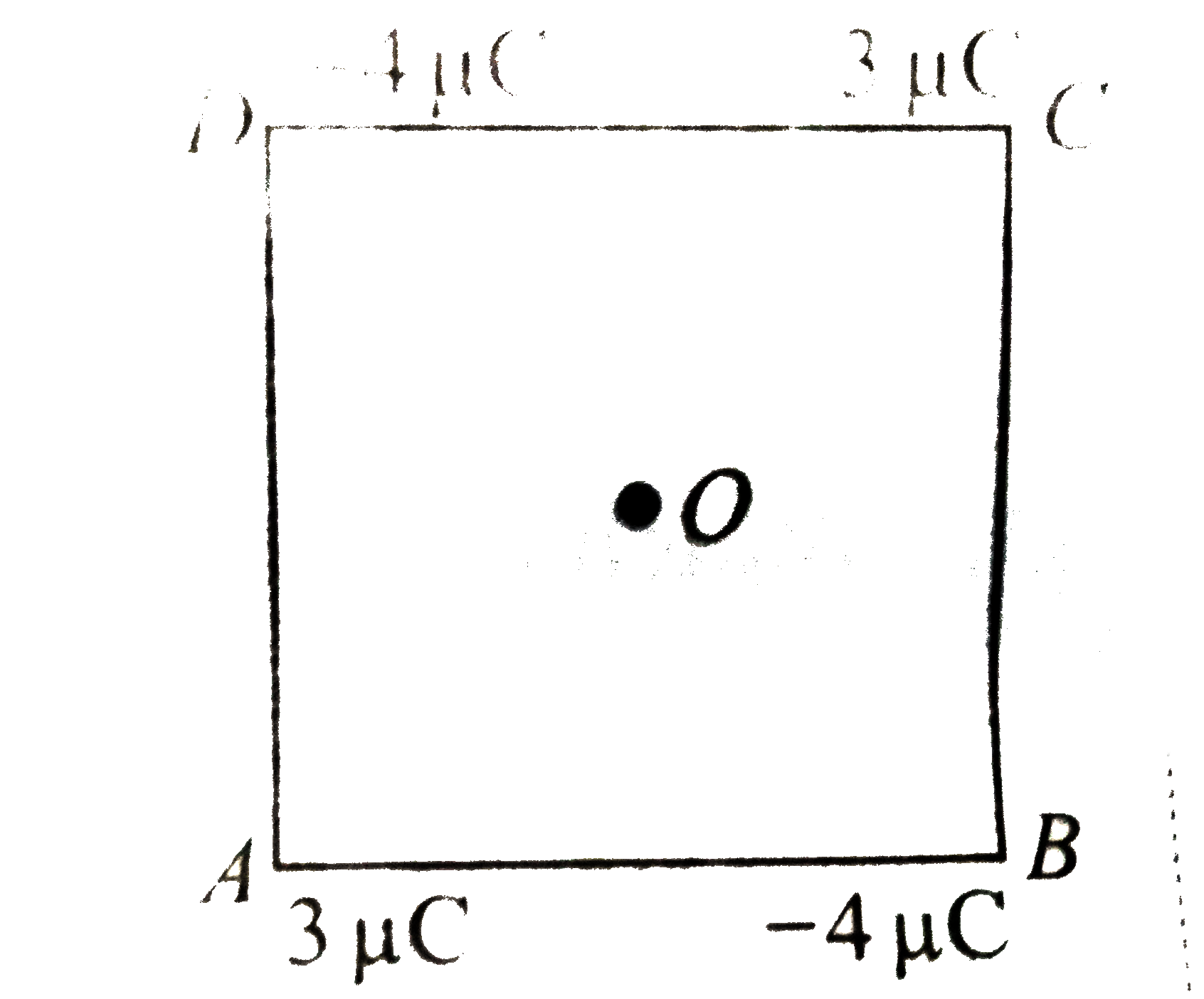Calculate the electric potential at the center of a square of side √2m, having charges 100μc,−50μC,20μcand−60μC at the four corners of the square.
21.6 N
64.8 N
0
43.2 N
The correct Answer is:D
To calculate the electric potential at the center of a square with side length √2 m and charges 100μC, −50μC, 20μC, and −60μC located at the corners, we will follow these steps:
Step 1: Determine the distance from each charge to the center of the square.
The diagonal D of the square can be calculated using the Pythagorean theorem:
D=√(side)2+(side)2=√(√2)2+(√2)2=√2+2=√4=2m
The distance from the center to each corner (which is half the diagonal) is:
r=D2=22=1m
Step 2: Use the formula for electric potential.
The electric potential V at a point due to a point charge is given by:
V=kQr
where k=9×109N m2/C2 is Coulomb's constant, Q is the charge, and r is the distance from the charge to the point.
Step 3: Calculate the total electric potential at the center.
The total potential at the center due to all four charges is the algebraic sum of the potentials due to each charge:
Vtotal=V1+V2+V3+V4
Calculating each potential:
- For Q1=100μC=100×10−6C:
V1=k100×10−61=9×109×100×10−6=9×104V
- For Q2=−50μC=−50×10−6C:
V2=k−50×10−61=9×109×−50×10−6=−4.5×104V
- For Q3=20μC=20×10−6C:
V3=k20×10−61=9×109×20×10−6=1.8×104V
- For Q4=−60μC=−60×10−6C:
V4=k−60×10−61=9×109×−60×10−6=−5.4×104V
Step 4: Sum the potentials.
Now, we sum all the potentials:
Vtotal=9×104+(−4.5×104)+1.8×104+(−5.4×104)
Calculating this step by step:
Vtotal=9×104−4.5×104+1.8×104−5.4×104
=(9−4.5+1.8−5.4)×104
=(9−4.5−5.4+1.8)×104=(1.8)×104V
Final Answer:
The electric potential at the center of the square is:
Vtotal=1.8×104V
D=√(side)2+(side)2=√(√2)2+(√2)2=√2+2=√4=2m
The distance from the center to each corner (which is half the diagonal) is:
r=D2=22=1m
V=kQr
where k=9×109N m2/C2 is Coulomb's constant, Q is the charge, and r is the distance from the charge to the point.
Vtotal=V1+V2+V3+V4
- For Q1=100μC=100×10−6C:
V1=k100×10−61=9×109×100×10−6=9×104V
V2=k−50×10−61=9×109×−50×10−6=−4.5×104V
V3=k20×10−61=9×109×20×10−6=1.8×104V
V4=k−60×10−61=9×109×−60×10−6=−5.4×104V
Vtotal=9×104+(−4.5×104)+1.8×104+(−5.4×104)
Calculating this step by step:
Vtotal=9×104−4.5×104+1.8×104−5.4×104
=(9−4.5+1.8−5.4)×104
=(9−4.5−5.4+1.8)×104=(1.8)×104V
The electric potential at the center of the square is:
Vtotal=1.8×104V
Topper's Solved these Questions
- ELECTROSTATICSBOOK - RESONANCE ENGLISHCHAPTER - ELECTROSTATICSEXERCISE - Part- II
20 Videos
- ELECTROSTATICSBOOK - RESONANCE ENGLISHCHAPTER - ELECTROSTATICSEXERCISE - Part - IV
9 Videos
- ELECTROSTATICSBOOK - RESONANCE ENGLISHCHAPTER - ELECTROSTATICSEXERCISE - Part - III
20 Videos
- ELECTROMAGNETIC INDUCTIONBOOK - RESONANCE ENGLISHCHAPTER - ELECTROMAGNETIC INDUCTIONEXERCISE - A.l.P
19 Videos
- EXPERIMENTAL PHYSICSBOOK - RESONANCE ENGLISHCHAPTER - EXPERIMENTAL PHYSICSEXERCISE - PART -II
10 Videos
Similar Questions
Find the electric field and potential at the centre of a square of side d = 10 cm. Four identical charges of q=2μC each are kept at the four corners of a square.
View SolutionCalculate electrostatic potential energy stored in a system consisting of two point charges 100μC and 40μC separated by a distance of 9cm, in vacuum.
View SolutionFour point charges are placed at the corners of a square ABCD of side 10 cm, as shown in figure. The force on a charge of 1μC placed at the centre of square is

View SolutionThe electric intensity due to a dipole of length 10cm and having a charge of 500μC, at a point on the axis at a distance 20cm from one of the charges in air is
View SolutionElectric charges of +10μC,+5μC,−3μCand+8μC are placed at the corners of a square of side √2 m, the potential at the centre of the square is
View SolutionFind the work done in taking a charge 100μC from C & D.
View SolutionFour identical positive point charges Q are fixed at the four corners of a square of side length l. Another charged particle of mass m and charge +q is projected towards centre of square from a large distance along the line perpendicular to plane of square. The minimum value of initial velocity v0 (in m/s) required to cross the square is ?
(m=1gm,l=4√2m,Q=1μc,q=0.5μc)

View SolutionThe net electric force on a charge of +3μC at the mid-point on the line joining two charges of magnitude +2μC and +2μC separated by the distance of 6 mm, is
View SolutionCalculate the amount of work done to dissociate a system of 3 charges 1μC,1μC and 4μC placed on the vertices of an equilateral triangle of sides 10 cm.
View SolutionCalculate the amount of work done to dissociate a system of three charges 1μC,1μCand−4μC placed on vertices of an equilateral triangle of side 10 cm.
View Solution

